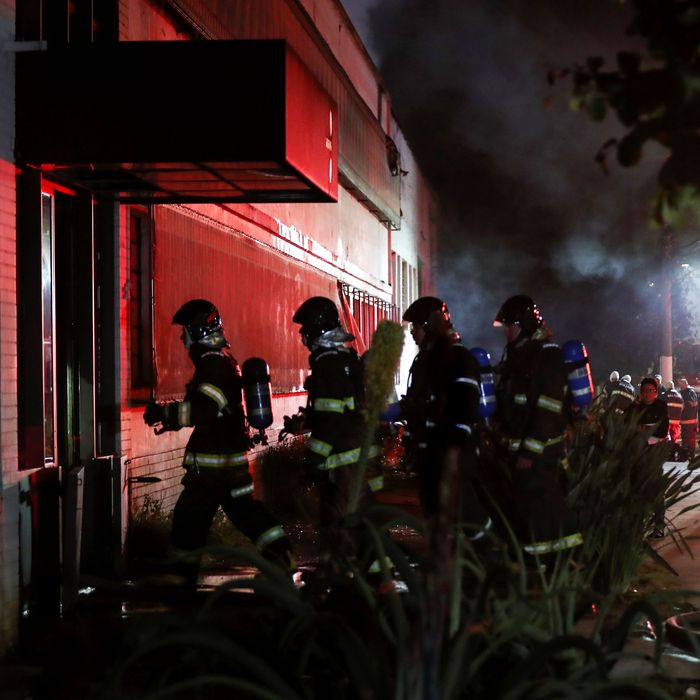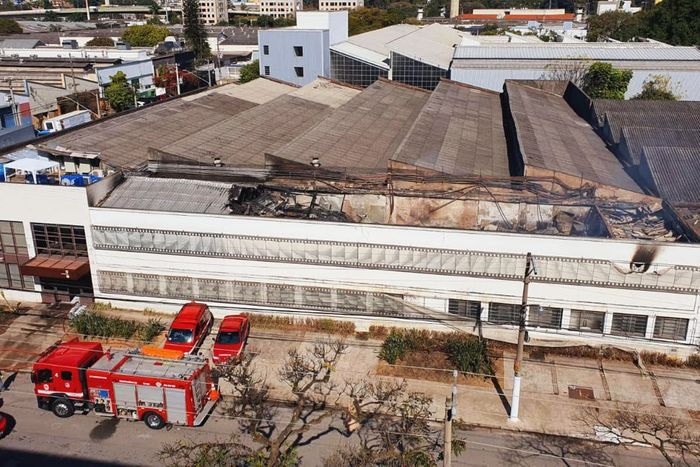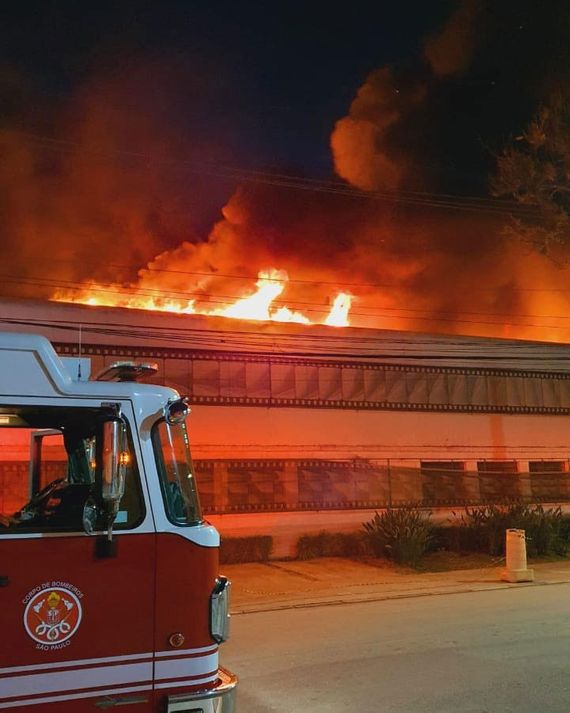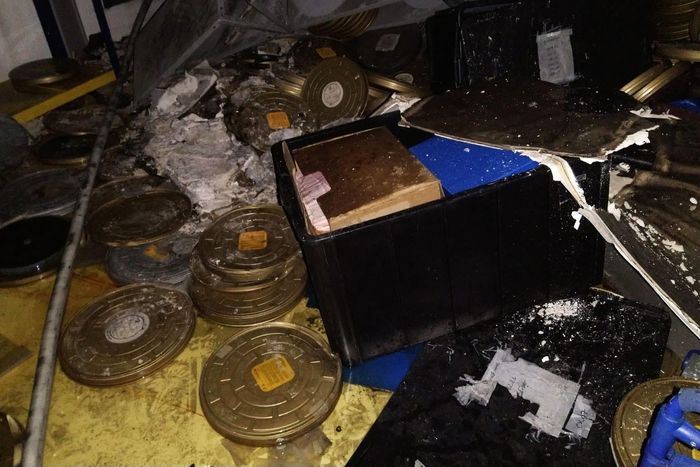
It was just after 6 p.m. on Thursday, July 29, when a fire broke out at a storage facility in São Paulo’s Vila Leopoldina, belonging to the Cinemateca Brasileira, the largest collection of moving images in South America. Firemen fought to contain the blaze for over four hours, as bright-red flames and thick smoke engulfed the top floors of a warehouse that houses the bulk of Brazil’s national cinematic output. Among the famous films stored at the federally funded Cinemateca are Anselmo Duarte’s The Payer of Vows, which won the Golden Palm at the Cannes Film Festival in 1962, and Cinema Novo classics like Nelson Pereira dos Santos’s Barren Lives (1963), Glauber Rocha’s Black God, White Devil (1964), and Joaquim Pedro de Andrade’s Macunaíma (1969).
Contrary to earlier reports, original copies of famous Brazilian films like these were not in the Vila Leopoldina facility. (They are primarily stored at Cinemateca’s main complex in Vila Clementino.) Nevertheless, four tons of documents and secondary copies of films, plus newsreels and miscellanea — old projectors meant for display and other, more necessary equipment used to repair current machines — were lost in the fire. An un-digitized portion of Rocha’s library, Tempo Glauber, went up in smoke, too.
The fire is believed to have sparked after a company subcontracted to update the warehouse’s air-conditioning units visited the site. Though there were reportedly no nitrate materials at the warehouse, the speed with which the fire spread suggests there were acetate materials present; both are bases of film stock used by cinematographers until the 1950s. It’s all too familiar. In 2018, a spark from air-conditioning units caused the devastating fire that nearly destroyed the National Museum in Rio de Janeiro, with precious scientific and cultural artifacts lost to the flames.
“It’s very quick to burn and destroy,” the Berlin-based Brazilian director Karim Aïnouz says of the most recent disaster, “but it’s going to take ages to get our country back.”
Cinemateca has suffered four prior fires — in 1957, 1969, 1982, and 2016. Thus news of the July 29 fire has been met with outrage, but, sadly, not surprise. “After the fire at the National Museum and multiple calls for help from the film community, nothing done,” the filmmaker Kleber Mendonça Filho wrote on Twitter. “It doesn’t even feel like an accident.” Just last year, the government dismissed all 62 Cinemateca staff members, effectively closing the institution. The Federal Public Ministry has since requested that a federal judge intervene on film collection’s behalf; however, the government passed the deadline set to take action. On July 20, just days before the fire, a judge gave the government 60 more days to prove it has taken decisive steps toward reopening the institution.
Roberto Gervitz, a coordinator behind SOS Cinemateca, a group created by the São Paulo Association of Filmmakers (APACI), describes the past year as “Cinemateca’s descent to hell.” But the institution’s troubles date back even further. In 2013, the dismissal of Cinemateca’s director, Carlos Magalhães, by the Culture Minister Marta Suplicy, resulted in an institutional crisis, with drastic cuts in staff and a lapse in government funding. A decade-long period of ambitious restoration projects — including the completed restoration of the jewel of Brazilian modernism, Limite (1931), in collaboration with World Cinema Foundation — came to a halt. In 2016, per the institution’s annual report, another shrunken budget limited institutional spending to “basic custodial needs, but not investments in infrastructure, or thorough attendance to the [archive’s] technical needs.” That year Cinemateca’s funding remained public, but its management passed to the private foundation, Associação de Comunicação Educativa Roquette Pinto (ACERP). More recently, in 2019, President Jair Bolsonaro dissolved the Ministry of Culture and froze the funds of Brazil’s National Film Agency (ANCINE). The following year, after the president failed to appoint his supporter, the actress Regina Duarte, as Cinemateca’s new director, the government canceled the contract with ACERP, thereby cutting off Cinemateca’s funding entirely. In August 2020 the new secretary of culture, actor Mário Frias, escorted by federal police, forced out all of Cinemateca’s remaining employees, whose salaries hadn’t been paid.
The fired workers took to social media with the hashtag #SOSCinematecaBrasileira. They organized as Trabalhadores da Cinemateca (Workers of Cinemateca), staged protests, and issued a manifesto, calling on the government to reinstate them. The government agreed to release a bid to recruit new management within two months of the firings. It did so only on Saturday, July 30, the day after the fire. Meanwhile SAC, which is managing Cinemateca in the interim, has proposed a project for emergency work that foresees some 40 workers returning to their posts. The government approved the project, but so far only custodial work has recommenced.
Basic maintenance isn’t enough. The workers have warned that the nitrate and acetate copies in Cinemateca’s possession require constant surveillance and upkeep, particularly in the extreme heat of Brazil. And it’s not just fires that plague the collection. Tiago Costa Gomes, formerly on technical staff at Cinemateca and a member of Trabalhadores, conducted an emergency assessment at the Villa Leopoldina location last year, after a severe flood at the warehouse damaged materials. That’s when the materials were moved from the lower floors to higher ground, where the 2021 fire struck.
For the São Paulo–based director Marco Dutra, the most recent fire — and the news that among the materials lost in the blaze are some of the 16 and 35mm films of cinema students at ECA [the Communication and Audiovisual School at the University of São Paulo] — is glum déjà vu. In 2001, when Dutra studied at the film school, a fire destroyed the building and most of the cinema department. “I recall the tears of our professors over their materials,” Dutra says. The 2021 fire has once again called the public’s attention to the government’s inadequate (or lack of) policies when it comes to preservation. “This government acts by inertia, and preservation is never part of its audiovisual policies. It’s always an afterthought,” says Debóra Butruce, a preservationist and president of the Brazilian Association of Audiovisual Preservation (ABPA).
Brazil’s negligence in preservation unfortunately isn’t an exception in Latin America. On July 16, the Argentine film historian Fernando Martin Peña decried new laws governing cinema that are under consideration in his country, directing a Twitter denunciation not toward the government but the film industry: “The scant importance (and the uncertain budget forecasts) given to preservation is terrifying. As always, the film community wants money for production. It cares NOTHING about preservation.”
The widespread sharing of images on the internet furthers the confusion about the importance of physical film preservation, according to Butruce. “The general public stores images on paid online platforms, which in fact don’t guarantee the maintenance of personal archives,” says Butruce. Meanwhile, Cinemateca’s Cultural Data Bank has been nonfunctional for a year. Searches through the institution’s online archives regularly lead to pages that don’t work.
“The federal government’s negligence brutally compromises the present production and research,” says Amir Labaki, the founder and director of It’s All True (É Tudo Verdade) International Documentary Film Festival, partly held at Cinemateca. Labaki’s comment reflects the frustration of the wider film community, which sees no end to the institution’s agony.
Contesting the government’s open bid for Cinemateca’s new management is the next grave challenge. Protests at the institution are reportedly being scheduled for this weekend, the one-year anniversary of Cinemateca’s shutdown. “The bid should be canceled. Its proposed budget [10 million reais a year, or just under $2 million] is extremely low. It doesn’t guarantee Cinemateca’s survival,” Gervitz says. As for the government’s attempts to force filmmakers to pay for depositing their films in the archive, Gervitz reiterates, “Cinemateca should not be a service provider. It is a depository of our national memory, it’s our historical patronage.”
“We’ve lost our voice and our autonomy,” says Karim Aïnouz, who sees the fire as a symptom of the same political quagmire that allows for the burning of the Amazon and the deaths of over half a million Brazilian people during the pandemic. Ahead of the 2022 presidential election, he feels a sense of urgency. “It is time to convert our indignation into concrete political action and to fight,” he says. “We must get our oxygen back.”







